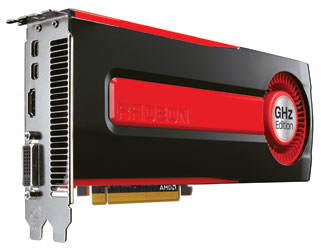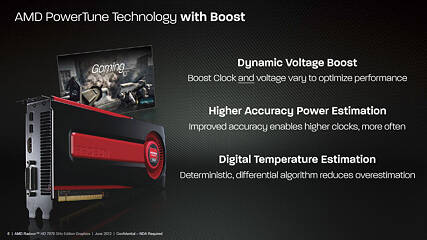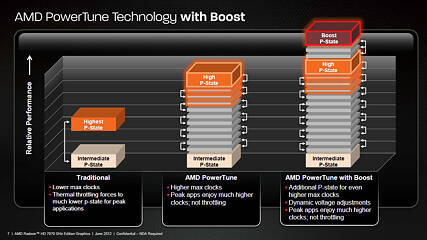 222
222
AMD Radeon HD 7970 GHz Edition 3 GB Review
Packaging & Contents »Introduction

AMD launches its newest graphics processor, the Radeon HD 7970 GHz Edition, in a desperate bid to reclaim the single-GPU performance crown from NVIDIA. The move sparks a sense of déjà vu, taking us back to mid-2009, when AMD created the Radeon HD 4890 to compete against the then cheapened GeForce GTX 260 Core 216. While the HD 4890 used a new, redesigned ASIC, the new HD 7970 GHz Edition sticks to the same one as the HD 7970.
The Radeon HD 7970 GHz Edition ships with about 13.5% higher GPU and 9% higher memory clock speeds, it gets its "GHz Edition" brand extension from its ≥1 GHz GPU clock speed. Radeon HD 7870 and Radeon HD 7770 are the other GHz Edition SKUs from AMD. Increased clock speeds aren't the only things new about the HD 7970 GHz Edition; it is also the first high-end AMD GPU to feature PowerTune with Boost, a similar-sounding feature to NVIDIA GPU Boost.
The core of the HD 7970 GHz Edition is clocked as high as 1000 MHz, with a Boost frequency of 1050 MHz; while the memory is upped to 1500 MHz (actual) or 6.00 GHz (GDDR5 effective), resulting in a staggering 288 GB/s bandwidth thanks to the 384-bit wide memory interface. The PowerTune with Boost, on the other hand, is an evolution of AMD's PowerTune technology. Whereas PowerTune provides high maximum clock speeds, PowerTune with Boost uses a new deterministic algorithm that takes into account power-draw and temperatures, to find more opportunities to boost the clock speed. The technology even tunes the voltage, if it is required to support the Boost state, as long as power-draw and temperatures are within acceptable limits.

The card itself doesn't look any different from the reference design Radeon HD 7970, right down to its PCB layout, although we expect the SKU to be mostly sold as non-reference design graphics cards by AMD's contingent of add-in board partners. The move by AMD is to minimize development costs for itself, and its partners. AMD's one point agenda with the Radeon HD 7970 GHz Edition is retaking the performance crown from NVIDIA GeForce GTX 680. It is also priced on-par with it. In this review we will find out if AMD succeeds at it, and if so, at what 'cost'.
| GeForce GTX 580 | Radeon HD 7950 | GeForce GTX 670 | Radeon HD 7970 | HD 7970 GHz Edition | GeForce GTX 680 | Radeon HD 6990 | GeForce GTX 590 | GeForce GTX 690 | ||
|---|---|---|---|---|---|---|---|---|---|---|
| Shader Units | 512 | 1792 | 1344 | 2048 | 2048 | 1536 | 2x 1536 | 2x 512 | 2x 1536 | |
| ROPs | 48 | 32 | 32 | 32 | 32 | 32 | 2x 32 | 2x 48 | 2x 32 | |
| Graphics Processor | GF110 | Tahiti | GK104 | Tahiti | Tahiti | GK104 | 2x Cayman | 2x GF110 | 2x GK104 | |
| Transistors | 3000M | 4310M | 3500M | 4310M | 4310M | 3500M | 2x 2640M | 2x 3000M | 2x 3500M | |
| Memory Size | 1536 MB | 3072 MB | 2048 MB | 3072 MB | 3072 MB | 2048 MB | 2x 2048 MB | 2x 1536 MB | 2x 2048 MB | |
| Memory Bus Width | 384 bit | 384 bit | 256 bit | 384 bit | 384 bit | 256 bit | 2x 256 bit | 2x 384 bit | 2x 256 bit | |
| Core Clock | 772 MHz | 800 MHz | 915 MHz+ | 925 MHz | 1050 MHz | 1006 MHz+ | 830 MHz | 607 MHz | 915 MHz+ | |
| Memory Clock | 1002 MHz | 1250 MHz | 1502 MHz | 1375 MHz | 1500 MHz | 1502 MHz | 1250 MHz | 855 MHz | 1502 MHz | |
| Price | $380 | $380 | $400 | $450 | $500 | $500 | $700 | $750 | $999 |
Apr 19th, 2025 07:23 EDT
change timezone
Latest GPU Drivers
New Forum Posts
- 3090 zotac Trinity Oc dead or psu weak? (42)
- AAF Optimus Modded Driver For Windows 10 & Windows 11 - Only for Realtek HDAUDIO Chips (429)
- TPU's Nostalgic Hardware Club (20260)
- RX 9000 series GPU Owners Club (402)
- [Test Build] Fix for 576.02 Driver Install (8)
- Looking for a rolling workbench recommendation (12)
- 5070ti overclock...what are your settings? (12)
- Which 5080 graphics card? (11)
- NVIDIA GeForce 576.02 WHQL driver (6)
- need help with 12900hx (0)
Popular Reviews
- ASUS GeForce RTX 5060 Ti TUF OC 16 GB Review
- NVIDIA GeForce RTX 5060 Ti PCI-Express x8 Scaling
- ASRock X870E Taichi Lite Review
- Palit GeForce RTX 5060 Ti Infinity 3 16 GB Review
- Teevolution Terra Pro Review
- ASUS GeForce RTX 5060 Ti Prime OC 16 GB Review
- MSI GeForce RTX 5060 Ti Gaming OC 16 GB Review
- Zotac GeForce RTX 5060 Ti AMP 16 GB Review
- MSI GeForce RTX 5060 Ti Gaming Trio OC 16 GB Review
- G.SKILL Trident Z5 NEO RGB DDR5-6000 32 GB CL26 Review - AMD EXPO
Controversial News Posts
- NVIDIA GeForce RTX 5060 Ti 16 GB SKU Likely Launching at $499, According to Supply Chain Leak (182)
- NVIDIA Sends MSRP Numbers to Partners: GeForce RTX 5060 Ti 8 GB at $379, RTX 5060 Ti 16 GB at $429 (127)
- Nintendo Confirms That Switch 2 Joy-Cons Will Not Utilize Hall Effect Stick Technology (105)
- NVIDIA Launches GeForce RTX 5060 Series, Beginning with RTX 5060 Ti This Week (104)
- Over 200,000 Sold Radeon RX 9070 and RX 9070 XT GPUs? AMD Says No Number was Given (100)
- Nintendo Switch 2 Launches June 5 at $449.99 with New Hardware and Games (99)
- Sony Increases the PS5 Pricing in EMEA and ANZ by Around 25 Percent (85)
- NVIDIA PhysX and Flow Made Fully Open-Source (77)

